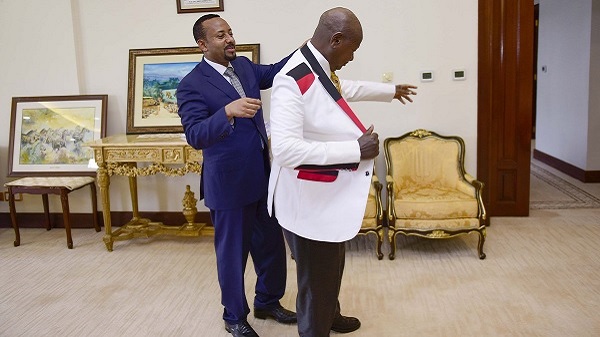
Traditional Ethiopian fashion is gaining more fame – thanks to the country’s Prime Minister Abiy Ahmed recently caused some buzz by giving handwoven jackets to the presidents of Rwanda and Uganda. Back home, it’s common attire for Ethiopians who are strongly attached to the clothing.
Addisu Tegegn, a fashion designer and owner of Addis Design in the capital, has received a fresh order for a jacket. His customer wants a black jacket decorated with Ethiopian woven fabric. The process entails cutting fabric into pieces, then assembling them before adding the final decorative touches. He will deliver it in four days.
Addisu says, “This is our typical designs the material also is by hand, made by hand weaving and embroidery also. That is the uniqueness of the traditional work.”
The fabric is made in the ancient traditional style, entirely by hand – manually. Yarn is manually spun and wound, then dyed to different colors before being taken for weaving. The shuttle and yarn are passed from one end of the loom to the other producing different designs.
WATCH: To Ethiopia’s clothes & traditional designs break into global market, a lot should be done
Addisu says, “The woven decorative designs come from the ancient Ethiopian kings and leaders. With time, it has been simplified through simpler design for young and old. This is one of the cultures. We have over 88 nations and nationalities in Ethiopia and all of them these embroidery designs.”
The colors symbolize which region an Ethiopian is from. Most of the jackets, shirts and dresses that Addisu makes are on order because he says different clients come with different preferences of designs.
The same work goes into shirt making. Tewodros Teffera, a resident of Addis Ababa, ordered a shirt a week ago, and chose to have crosses put on the chest. He says, “Most of the time people like buying and dressing in European clothes. So for the past few years, I have started wearing these clothes like my cultural clothes like shirts, coats trousers, so it representing not Europeans, it is African and Ethiopians.”
———————————————-
———————————————-
Machine embroidery is also added to some items as part of the detail.
Zelalem Tufa, an embroidery expert on traditional Ethiopian fashion, says, “This hand-woven fabric we call shama, can never be done by machine, only done by hand. We have tried to create using machine but have failed to get same quality.”
A traditional Ethiopian fashion shirt sells for about 40 dollars. But pieces with more intricate detail can fetch much more. Designers like Addisu are already striving to sell beyond Ethiopia. His pieces have been worn by international artists like Eddy Kenzo from Uganda, as well as Wiz Kid from Nigeria – giving him just the kind of exposure that might help put his work further on the map.
Source: CGTN
